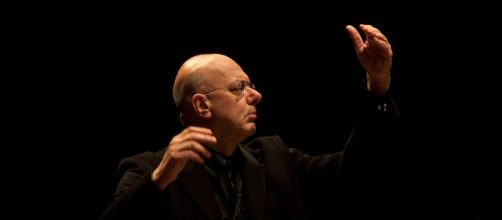Friday, Nov. 3, The Orchestra Now (TŌN), still in its infancy, comes to Carnegie Hall for its third season. Maestro Leon Botstein leads musicians selected from world-renowned conservatories in symphonic works by Bernard Herrmann and Erich Wolfgang Korngold, both of whom enjoyed distinguished Hollywood careers as film score composers. Herrmann’s lesser-known “Symphony No. 1” and Korngold’s “Symphony in F-Sharp” will follow Herrmann’s strings-only suite from the Alfred Hitchcock hit film “Psycho.” In an exclusive interview, Leon Botstein told Blasting News what drove him to found TŌN, what sets the ensemble apart from other orchestras and what he hopes audiences will take away from the Nov.
3 concert.
HERRMANN’S PSYCHO SUITE, 11/3 @carnegiehall Herrmann, Academy Award-winner & known for his Hitchcock collaborations https://t.co/GYKHA8dUjQ pic.twitter.com/tHK5kdTRXJ
— The Orchestra Now (@TheOrchNow) 19 October 2017
TŌN’s creation
Leon Botstein’s eloquent speech floats upon an appealing voice that most undergraduates would want to hear from their professors. He is—in no particular order—an editor, author, music historian, educator and conductor. In 2015 he founded, assembled, and began rehearsing and performing with TŌN. The ensemble will give its third season again at Carnegie Hall and at Fisher Center for the Performing Arts (Annandale-on-Hudson, New York). What drove the busy maestro to found TŌN?
He cites four aims:
- To provide performance experience and depth in orchestra practice—what’s missing from conservatory training.
- To teach how music links with history, politics, art, literature, philosophy …
- To introduce the younger generation to the task of recovering from obscurity the unfairly neglected treasures of music history, composers and repertoire that are not—but deserve to be—in the standard repertory.
- To help musicians become articulate organizers of their musical life, to become leaders, giving them skills for a more successful career.
How The Orchestra Now is different
Not a youth ensemble, TŌN is comprised of “ready-minted professionals who have all graduated from conservatories and have had professional experience before undertaking the program.” The average age is mid- to late-twenties.
Repertoire also differs from most ensembles. Oh, they perform the perennial favorites by Beethoven, Mahler, Tchaikovsky and other pillars of the Classical canon.
But their concert programs chiefly focus, according to Maestro Botstein, on “unknown great works by known composers and great works by composers of less-familiar names,” like Frank Martin, Bohuslav Martinů, Eugene Goossens, László Lajtha, Ahmed Adnan Saygun, Anton Rubenstein, Walter Braunfels, Einojuhani Rautavaara and living composers like Jennifer Higdon, Michael Daugherty, Heinz Karl Gruber.
A treasure trove
Why are such composers performance-worthy to Leon Botstein? He answers: “The 19th and 20th centuries are a tremendously rich repository of great music, an immense treasure trove of underperformed, fabulous works.” He feels a responsibility to make such works known, part of the standard repertory. “If we don’t bring these works to life, our art form is in danger because we essentially betray its own history.” He likens concert-goers to movie fans. “People don’t go to the movies to see ‘Casablanca’ every year. So why should we do that with music?” It is vital that he and TŌN continue exploring, in the face of an ever-shrinking repertory of concert warhorses.
Music’s link to art
Art often comes up in Maestro Botstein’s comments.
Citing da Vinci’s “Mona Lisa,” he says: “It’s the Louvre Museum’s most famous painting. Many go there just to see it. But more than half will wander through the museum and see great art that doesn’t have the same prominence.” But just hearing great music doesn’t suffice. He posits that “music only comes alive when it’s performed. You may find a recording of a lesser-known composition on YouTube or examine the score from a library, but that’s not the same. It’s like looking at a photo of a masterpiece in an art textbook instead of examining the painting itself.”
Going a step further
Starting Dec. 3, Leon Botstein will lead TŌN in three concerts in their “Sight & Sound” series—which juxtaposes music and art—at the Metropolitan Museum of Art’s Grace Rainey Rogers Auditorium.
Drawing the link between music and art, excerpts from Arnold Schoenberg’s operatic monodrama, “Erwartung” (Expectation), will be performed in plain view of artwork by Edvard Munch (think “The Scream”), complementing the museum exhibit “Edvard Munch: Between the Clock and the Bed.” The other concerts pair Shostakovich with Michelangelo and Debussy with Manet, Degas and Whistler, in harmony with similar exhibits then at the museum.
Our Sight & Sound series continues–@metmuseum where we explore the parallels btwn orchestral music & the visual arts https://t.co/yW0yVqYDeI pic.twitter.com/U39WJHQwWe
— The Orchestra Now (@TheOrchNow) 4 October 2017
What to expect
Maestro Botstein points out that Bernard Herrmann and Erich Wolfgang Korngold “are famous primarily for their film scores.
But our Nov. 3 Carnegie Hall concert will generate excitement by encountering their extremely compelling works that are unfamiliar.” He promises: “The freshness, vitality, and richness of musical heritage comes alive” through his work with TŌN.
Herrmann’s First Symphony and “Psycho” film score, Korngold’s “Symphony in F-Sharp,” 7:30 p.m. Friday, Nov. 3, Carnegie Hall, 57th Street and Seventh Avenue, Manhattan.
TŌN will be performing at @carnegiehall, Nov 3. The Program: Herrmann's Psycho Suite. https://t.co/8f2JAv3Iey Info: https://t.co/GYKHA8dUjQ
— The Orchestra Now (@TheOrchNow) 17 October 2017


